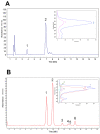Carotenoid Cocktail Produced by An Antarctic Soil Flavobacterium with Biotechnological Potential
- PMID: 34946021
- PMCID: PMC8704924
- DOI: 10.3390/microorganisms9122419
Carotenoid Cocktail Produced by An Antarctic Soil Flavobacterium with Biotechnological Potential
Abstract
Carotenoids are highly important in pigmentation, and its content in farmed crustaceans and fish correlates to their market value. These pigments also have a nutritional role in aquaculture where they are routinely added as a marine animal food supplement to ensure fish development and health. However, there is little information about carotenoids obtained from Antarctic bacteria and its use for pigmentation improvement and flesh quality in aquaculture. This study identified carotenoids produced by Antarctic soil bacteria. The pigmented strain (CN7) was isolated on modified Luria-Bertani (LB) media and incubated at 4 °C. This Gram-negative bacillus was identified by 16S rRNA analysis as Flavobacterium segetis. Pigment extract characterization was performed through high-performance liquid chromatography (HPLC) and identification with liquid chromatography-mass spectrometry (LC-MS). HPLC analyses revealed that this bacterium produces several pigments in the carotenoid absorption range (six peaks). LC-MS confirms the presence of one main peak corresponding to lutein or zeaxanthin (an isomer of lutein) and several other carotenoid pigments and intermediaries in a lower quantity. Therefore, we propose CN7 strain as an alternative model to produce beneficial carotenoid pigments with potential nutritional applications in aquaculture.
Keywords: Antarctic Flavobacterium; aquaculture; carotenoids; lutein; zeaxanthin.
Conflict of interest statement
The authors declare that the research was conducted in the absence of any commercial or financial relationships that could be construed as a potential conflict of interest.
Figures





References
-
- Dieser M., Greenwood M., Foreman C.M. Carotenoid pigmentation in Antarctic heterotrophic bacteria as a strategy to withstand environmental stresses. Arctic Antarct. Alp. Res. 2010;42:396–405. doi: 10.1657/1938-4246-42.4.396. - DOI
-
- Reis-Mansur M.C.P.P., Cardoso-Rurr J.S., Silva J.V.M.A., de Souza G.R., da Silva Cardoso V., Mansoldo F.R.P., Pinheiro Y., Schultz J., Lopez Balottin L.B., da Silva A.J.R., et al. Carotenoids from UV-resistant Antarctic Microbacterium sp. LEMMJ01. Sci. Rep. 2019;9:1–14. doi: 10.1038/s41598-019-45840-6. - DOI - PMC - PubMed
LinkOut - more resources
Full Text Sources
Molecular Biology Databases

